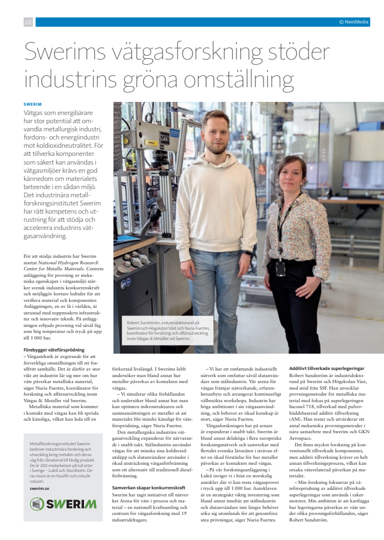Contact



Hydrogen research supports the industry's green transition
Hydrogen as an energy carrier has great potential to transform the metallurgical, automotive, and energy industries toward carbon neutrality. To manufacture components that can safely operate in hydrogen environments, it is essential to understand how materials behave under such conditions. The industry-focused metals research institute Swerim possesses the necessary expertise and equipment to support and accelerate the industry's adoption of hydrogen.

Future Research: Swerim’s Hydrogen Initiative
To support the industry, Swerim has launched the National Hydrogen Research Center for Metallic Materials. The facility, which tests mechanical properties in hydrogen environments, strengthens the competitiveness of Swedish industry and shortens lead times for verifying materials and components. It is one of only a few such facilities in the world, equipped with state-of-the-art infrastructure and innovative technology. Testing is offered at both low and high temperatures and at pressures up to 1,000 bar.
Preventing Hydrogen Embrittlement
“Hydrogen technology is crucial for achieving the transition to a fossil-free society. That’s why it’s so important for industry to better understand how hydrogen affects metallic materials,” says Nuria Fuertes, coordinator for research and business development in Hydrogen & Metals at Swerim.
Metallic materials that come into contact with hydrogen can become brittle and sensitive, leading to a shortened service life. In Swerim’s lab, researchers study how metals are affected by hydrogen exposure.
“We simulate various conditions and examine how to optimize the microstructure and composition of metals to make them less susceptible to hydrogen embrittlement,” says Nuria Fuertes.
The hydrogen transformation in the metallurgical industry is currently expanding rapidly. The steel industry is increasingly using hydrogen to reduce CO₂ emissions, and end-users are turning to hydrogen combustion as an alternative to conventional diesel engines.
Collaboration Drives Competitiveness
Swerim has initiated the network Arena for Hydrogen in Process and Materials – a national effort and hub for hydrogen research with 19 industrial partners.
“We have a broad industrial network that includes both end-users and the steel industry. Our hydrogen arena promotes collaboration, knowledge-sharing, and regularly hosts well-attended workshops. Industry has high ambitions for hydrogen use, and there’s a great need for increased expertise,” says Nuria Fuertes.
Hydrogen research has expanded rapidly in recent years. Swerim is involved in several European research networks and collaborates with multiple Swedish universities to deepen the understanding of how metals are affected by hydrogen exposure.
“This autumn, we’re inaugurating a large-scale autoclave at our research facility in Luleå, where we can test hydrogen samples at pressures up to 1,000 bar. The autoclave is a strategically important investment that means the steel industry and end-users no longer need to go abroad for such tests,” says Nuria Fuertes.
Additively Manufactured Superalloys
Robert Sundström is an industrial PhD student at Swerim and University West, supported by the Swedish Foundation for Strategic Research (SSF). He develops test methods for metallic materials, focusing on the superalloy Inconel 718, manufactured using powder bed-based additive manufacturing (AM). He tests and evaluates various mechanical testing methods in close collaboration with Swerim and GKN Aerospace.
There is extensive research on conventionally manufactured components, but additive manufacturing involves entirely different processes, which can cause hydrogen-related effects in the material.
“My research focuses on hydrogen embrittlement in additively manufactured superalloys used in rocket engines. My goal is to map how these alloys are affected by hydrogen under different testing conditions,” says Robert Sundström.
This article was published in Future Research 2025 (Framtidens Forskning 2025), a magazine by the Swedish Foundation for Strategic Research (SSF).
